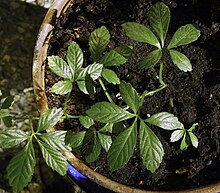| Gynostemma | |
|---|---|

| |
| Gynostemma pentaphyllum growing in potting soil | |
| Scientific classification | |
| Kingdom: | Plantae |
| Clade: | Tracheophytes |
| Clade: | Angiosperms |
| Clade: | Eudicots |
| Clade: | Rosids |
| Order: | Cucurbitales |
| Family: | Cucurbitaceae |
| Tribe: | Gomphogyneae |
| Genus: | Gynostemma Blume |
| Species | |
|
See text | |
Gynostemma is a genus of perennial climbing vines in the cucumber, gourd, and melon family, comprising at least 19 species, all native to the tropical East or Far East, inclusive of the Himalayas: China (with 9 endemic); the islands of Japan; Malaysia; and New Guinea. The term Gynostemma is derived from Ancient Greek γυνή meaning "woman" or "female", and στέμμα meaning "wreath" or "garland". In (post-)classical Latin the form stemma is attested as Greek loanword. In Ancient Greek and Latin, stemma is of neuter gender. German-Dutch botanist Carl Ludwig Blume described Gynostemma from two species he named: G. pedata (later changed, to pedatum) and G. simplicifolia (also later changed, to simplicifolium). Neither species was clearly designated by him as the type; however, the former species, G. pedatum is now considered to be a synonym of G. pentaphyllum (Thunb.) Makino. The genus was published in 1825, in Carl Ludwig von Blume's Bijdragen tot de flora van Nederlandsch Indië ("Contributions to the flora of the Dutch East Indies").
General description
All species of Gynostemma have tendrils (usually branching); most are dioecious. The leaves are usually in palmately arrayed leaflets (3–9, ovate-lanceolate in shape), arranged alternately on the stem; a few species are leaved, but without leaflets. Inflorescences are either racemose or paniculate. Fruits can be capsular or pea-like, containing two or three seeds.
Selected species
- Gynostemma aggregatum C.Y.Wu & S.K.Chen
- Gynostemma burmanicum King ex Chakrav.
- Gynostemma cardiospermum Cogn. ex Oliv.
- Gynostemma caulopterum S.Z.He
- Gynostemma compressum X.X.Chen & D.R.Liang
- Gynostemma guangxiense X.X.Chen & D.H.Qin
- Gynostemma intermedium W.J.de Wilde & Duyfjes
- Gynostemma laxiflorum C.Y.Wu & S.K.Chen
- Gynostemma laxum (Wall.) Cogn.
- Gynostemma longipes C.Y.Wu
- Gynostemma microspermum C.Y.Wu & S.K.Chen
- Gynostemma pallidinervee Z.Zhang
- Gynostemma papuanum W.J.de Wilde & Duyfjes
- Gynostemma pentagynum Z.P.Wang
- Gynostemma pentaphyllum (Thunb.) Makino
- Gynostemma pubescens (Gagnep.) C.Y.Wu
- Gynostemma simplicifolium Blume
- Gynostemma yixingense (Z.P.Wang & Q.Z.Xie) C.Y.Wu & S.K.Chen
- Gynostemma zhejiangense X.J.Xue
- List source :
References
- ^ Gynostemma was originally described and published in Bijdragen tot de flora van Nederlandsch Indië 23. 1825. "Name - !Gynostemma Blume". Tropicos. Saint Louis, Missouri: Missouri Botanical Garden. Retrieved December 1, 2012.
- ^ Shukun Chen; Charles Jeffrey. "Gynostemma". Flora of China. 19. eFloras. Retrieved December 1, 2012.
- ^ Liddell, H.G. & Scott, R. (1940). A Greek-English Lexicon. revised and augmented throughout by Sir Henry Stuart Jones. with the assistance of. Roderick McKenzie. Oxford: Clarendon Press.
- ^ Lewis, C.T. & Short, C. (1879). A Latin dictionary founded on Andrews' edition of Freund's Latin dictionary. Oxford: Clarendon Press.
- Saalfeld, G.A.E.A. (1884). Tensaurus Italograecus. Ausführliches historisch-kritisches Wörterbuch der Griechischen Lehn- und Fremdwörter im Lateinischen. Wien: Druck und Verlag von Carl Gerold's Sohn, Buchhändler der Kaiserl. Akademie der Wissenschaften.
- ^ Original text by Carl Ludwig von Blume (1825). Bijdragen tot de flora van Nederlandsch Indië. p. 23. Retrieved December 1, 2012.
- "Name - Gynostemma pedatum Blume". Tropicos. Retrieved December 1, 2012.
- "Name - !Gynostemma simplicifolium Blume". Tropicos. Retrieved December 1, 2012.
- "TPL, treatment of Gynostemma pedatum". The Plant List; Version 1. (published on the internet). Royal Botanic Gardens, Kew and Missouri Botanical Garden. 2010. Retrieved December 1, 2012.
- "TPL, treatment of Gynostemma". Retrieved December 1, 2012.
| Taxon identifiers | |
|---|---|
| Gynostemma | |